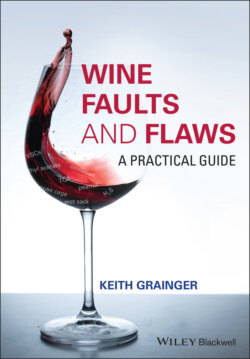Читать книгу Wine Faults and Flaws - Keith Grainger - Страница 36
1.12 The Incidence of Wine Faults
ОглавлениеShould there be any illusion that wine faults are a rare occurrence, at least insofar as faulty bottles reaching the consumer is concerned, let us look at the incidence as evidenced by wines entered into a major wine tasting competition. The ‘International Wine Challenge’ is one of the world's best known annual wine tasting competitions that now attracts over 10 000 entries a year. The AWRI has reviewed wines submitted for this competition but rejected as faulty during a period of 10 years from 2007 to 2016, and quantified these as to the category of fault, and also type of closure [24]. The total number of entries reviewed was 106 627. The figures regarding faults make shocking reading. Some 3.7% of the entries were faulty. Three‐quarters of the faulty wines (2.8% of the entries) showed one of three most common faults – oxidation (1.0% of the entries), so‐called ‘cork taint’ (0.9%) and reduction/sulfides (0.9%). Alarmingly, for the lovers of aged fine wines, over 7% of the entries that were over six years old exhibited a fault, with oxidation being the most common, although excessive volatile acidity is also noted. Whilst it is obviously not possible to extrapolate these figures onto a global scale, one might estimate that, based on OIV figures for the years 2007–2018, when global wine sales annually averaged 243 million hectolitres [25], each year the equivalent of some 1.2 billion 75 cl bottles of faulty wine are sold, and presumably the vast majority of these are consumed – a particularly sobering thought!
Let us also glance at some figures for wines ascertained to be faulty wines when sent for ranking in tasting assessment features in two UK published wine magazines: ‘Decanter’ and ‘The World of Fine Wine’. As detailed in Table 1.1, there were many instances when over 2% of the wines submitted were detected as being faulty. The publications named the wines they found to be faulty, and one can only speculate upon the impact that such naming had upon the producers.
Table 1.1 Percentage (if over 2%) of faulty wines submitted for panel tastings in two leading wine publications.
| Category of wines tasted | Date | No. tasted | No. faulty | % |
|---|---|---|---|---|
| Publication: Decanter | ||||
| Affordable Rioja | March 2020 | 183 | 4 | 2.2 |
| Priorat | November 2019 | 82 | 2 | 2.4 |
| Rosso di Montalcino | September 2019 | 93 | 2 | 2.2 |
| Value Douro Reds | July 2019 | 76 | 2 | 2.6 |
| South American Premium Red Blends | June 2019 | 98 | 3 | 3.1 |
| Chilean Sauvignon Blanc | October 2018 | 62 | 2 | 3.2 |
| South American Cabernet Franc | October 2018 | 44 | 1 | 2.3 |
| Gualtallary and Altamira Reds | October 2017 | 99 | 2 | 2.0 |
| New Zealand Sauvignon Blanc | August 2017 | 93 | 4 | 4.3 |
| Southern Rhône Whites | August 2017 | 96 | 2 | 2.1 |
| Piedmont Nebbiolo | July 2017 | 72 | 2 | 2.8 |
| Muscadet with extended lees ageing | June 2017 | 113 | 3 | 2.7 |
| Bordeaux Crus Bourgeois | April 2017 | 203 | 5 | 2.3 |
| Publication: The Word of Fine Wine | ||||
| Historic Non‐Vintage Champagne | Q3 2019 | 44 | 3 | 6.8 |
| Brunello di Montalcino 2012 | Q2 2017 | 34 | 1 | 2.9 |
| White Châteauneuf‐du‐Pape | Q1 2017 | 44 | 1 | 2.3 |
| Champagne 2008 and 2009 | Q4 2016 | 53 | 2 | 3.8 |
| Savennières | Q2 2016 | 27 | 1 | 3.7 |
It should be noted that there were also several wine categories assessed when none, or less than 2%, of the submitted samples were found to be faulty. However, the price points for the wine types detailed are generally relatively high, and if consumers find their purchases to be faulty they might well feel particularly aggrieved when discovering that the product in their glass is not worth anything, let alone the price paid.
